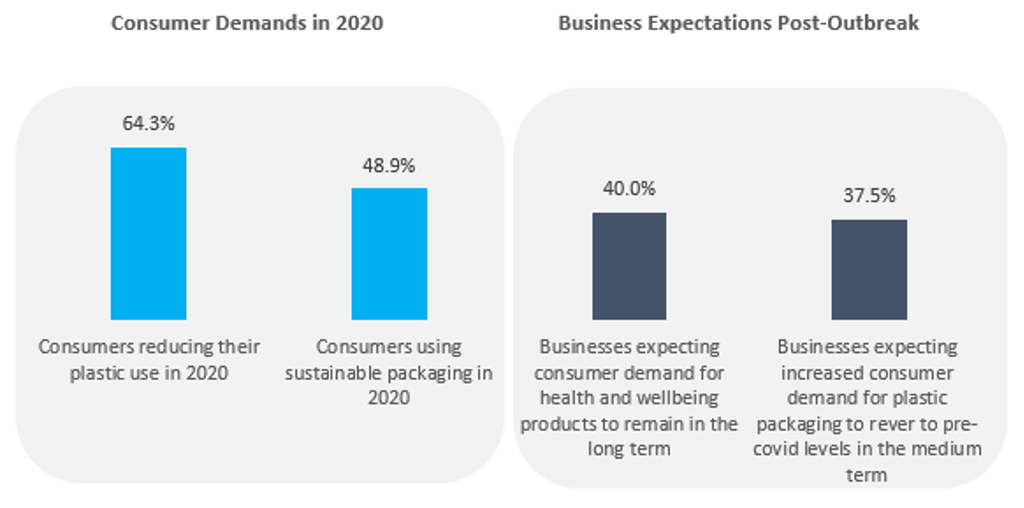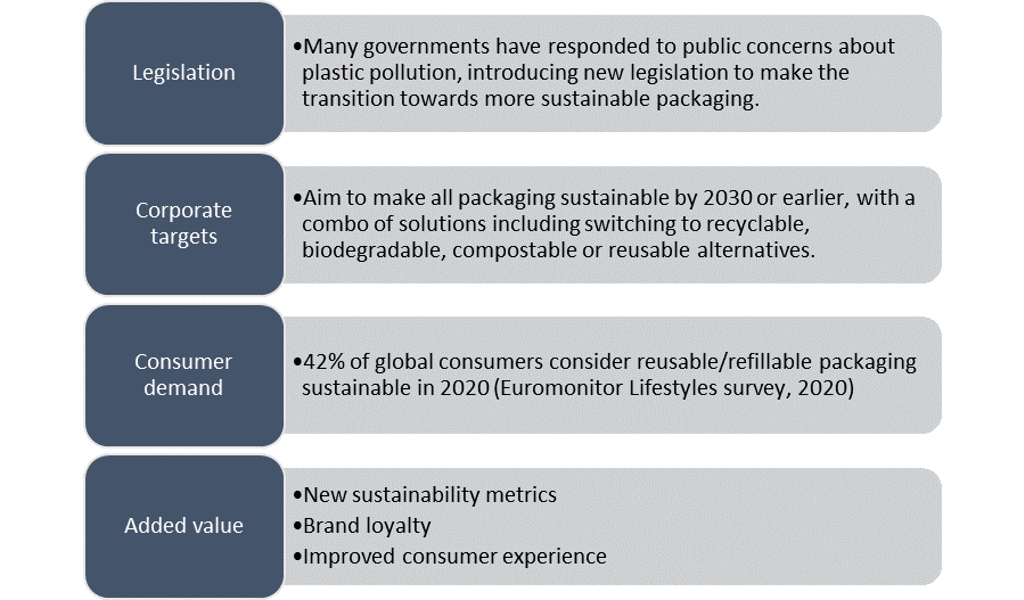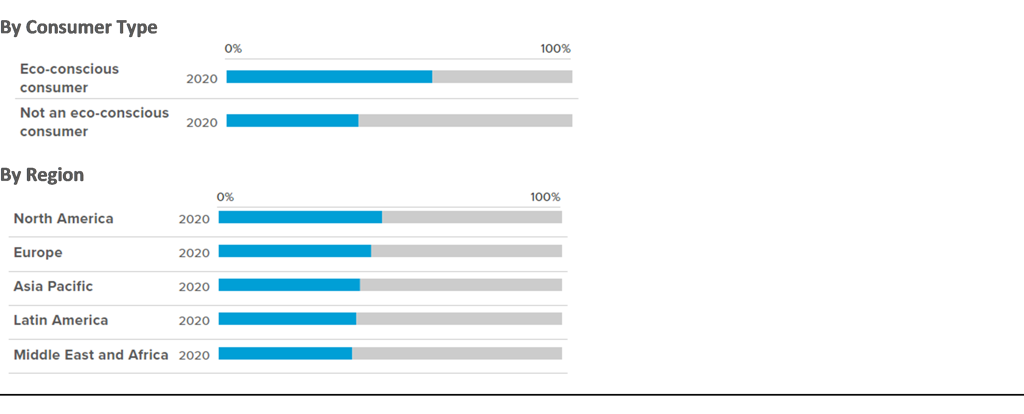From Sustainability to Purpose, one of the six Coronavirus (COVID 19) themes that Euromonitor International has identified set to transform consumer markets, talks about the acceleration of the purpose-driven movement in response to COVID-19. Businesses are acting less in self-interest, putting the creation of shared value at the top of the corporate agenda.
In 2020, Sustainability Insights Manager, Maria Coronado Robles and Head of Packaging Research, Rosemarie Downey, ran a number of digital events where they discussed global sustainability trends and the implications for the packaging industry. Here are the responses to a sample of questions that were asked.
Are brands and consumers still interested in sustainable packaging or has this stopped with the health-related concerns of the pandemic?
Environmental sustainability initiatives, including the development and launch of sustainable packaging, lowered in the list of priorities at the outset of the pandemic.
For consumers, packaging took on a new higher value related to its most basic premise of hygienic protection, bringing safety by minimising human touchpoints and helping expedite in-store grocery shopping and stockpiling products at home for added security. For brands, packagers and retailers, there was an understandable shift in attention from the environmental sustainability of the packaging to people’s immediate health and safety.
Despite the initial pause, packaging and plastic waste will remain top of mind in the new normal. Collaboration is essential to foster innovation, in order to deliver solutions with reduced environmental impact and greater safety.
Source: Euromonitor International Lifestyles survey, 2020 and Voice of the Industry: COVID-19, October 2020
In response, brands are keeping their sustainable packaging commitments, even launching stronger ones. Back in April 2020, Nestlé ramped up its investments in sustainable packaging, dedicating a £1.5 billion investment to accelerate the development of sustainable packaging solutions; other examples include the universal returnable bottle from Coca-Cola and the SodaStream solution from PepsiCo.
The legislation is supporting continuing progress too. Countries and regions differ in the level of legislation though. In Europe pre-COVID timelines of the EU Single-Use Plastic Directive (SUP) remain in place, targeting minimum levels of recycling and recycled content, adding to the sustainability momentum.
Post-pandemic user behaviour has turned to online shopping. Is there an option for sustainable packaging?
The pandemic has accelerated the shift to e-commerce. This brings opportunities for brands and packagers to develop further sustainable packaging that works specifically for online sales. However, online shopping also has the potential to affect packaging sustainability by generating more waste to handle in terms of protective delivery boxes, even if they are paper-based, recyclable and lightweight. Businesses need to rethink packaging design, balancing protection needs with convenience and sustainability.
The sustainability trend in online shopping was already underway pre-pandemic and therefore, there are some sustainable online fit packaging solutions being adopted by companies. For instance, the bag-in-box format more associated with boxed wine is used by Procter & Gamble’s Tide eco-box laundry detergent in North America and for some other of its home care brands. With consumers shopping bigger but less frequently, the bag-in-box solution improves product volume to packaging ratio, reducing overall packaging.
Reusable packaging for both the product itself and the shipping packaging has also become relevant with the rise in home-delivery of groceries. Companies such as LOOP or Algramo are capitalising on this opportunity in markets as diverse as North America, Latin America and Europe. Innovations in concentrate product formulations and refill pack solutions, in both conventional retail and as part of online/subscription models, are other solutions to reduce overall packaging use, but this should not be at the expense of the material’s reusability or recyclability.
Speaking about reusable packaging, why are brands interested in the Reuse Revolutionaries trend?
Businesses have ambitious sustainability commitments for their packaging that they need to fulfil and more stringent environmental legislation to comply with. In addition, consumers are increasingly worried about climate change and plastic pollution. Reusable packaging can bring additional benefits.
It reduces the amount of single-use plastic in circulation and therefore reliance on fossil fuels. The use of smart reusable/refillable packaging helps to build brand loyalty with deposit and reward schemes. Chilean start-up Algramo uses an RFID code on the bottle, so the company can give discounts on future purchases.
Smart packaging also enables the development of new sustainability metrics, allowing brands to track the number of times the packaging has been refilled and where. These metrics enable measurement of the environmental impact of reusable options versus their single-use counterpart.
And, despite up-front costs, reusable packaging can give businesses the opportunity to reduce costs (transportation and packaging) in the long-term.
Who are the consumers that are looking into reusable and refillable options? Are there any markets or demographics that are most receptive to this?
Although the appetite for reusable packaging is growing among all consumers, consumers that are more eco-conscious or empowered activists concerned about global issues, are aligning their actions with their values, thus more attracted to reusable/refillable options.
The Reuse Revolutionaries trend resonates more strongly with consumers in developed North America and Europe compared to other regions, where consumers seek a minimalist lifestyle and prefer to buy less but higher quality.
Demand for reusable alternatives is also higher with middle-class consumers, especially among women and couples with no children or with grown children, alongside among older consumers. Baby boomers are the most willing to use reusable packaging. This could be because they were used to reuse items in the past before the boom of on-the-go consumption and the rise in single-use plastics.
Consumers Who Consider Reusable/Refillable Packaging Sustainable
Source: Euromonitor International Lifestyles survey, 2020
To learn about the future of sustainability, access the reports Voice of the Industry: Sustainability in the Coronavirus Era and The Impact of Coronavirus on Packaging.




